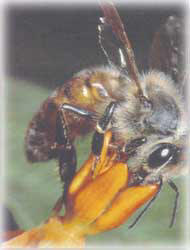Varroa Mites Beekeeper Tips

Female adult mites are brown to dark brown, shaped like a crab, measuring 1.00 to 1.5 mm long and 1.25 to 2 mm wide. They attach themselves into abdominal folds of the adult bee. Making difficult for the bee's to remove notice the picture from USDA Also they are soft bodied creatures; look at the picture below on right.
Problem with Varroa:
Suck the blood from both the adults and the developing brood, weakening and shortening the life span of the ones on which they feed. Brood may be deformed with missing legs or wings.
The biggest pest ever to face the beekeeper costing whole colines and the loss of thousands of dollars. What can be done other than using chemicals to try and rid the hive of the pest?
What can be done?
There are several things being done, lets consider two examples first selective breeding over several years to develop honey bees that groom themselves better and have a higher tolerance to the Varroa.
Another is good ventilation. There are many studies that show good ventilation can make a world of a difference.
First consider this, every year people that have wood stoves and hot air furnaces, dry out the humidity in the home and causing their (soft bodied) throats and nasal passages along with lips to dry out to the point of soar throats, bleeding noses, chap lips, also skin and scalp begin to scale.
My experience in bee keeping in the last 30 years is that the Varroa jacobsoni start to increase in numbers when the nectar flow starts, and the humidity jumps dramatically (every 3 lbs of nectar 2 lbs is water) in the hive. The hive environment is becoming a place where the Varroa (soft bodied, needing lots of humidity to survive) can now flourish. The simple answer, is extra good ventilation in the hive that will cause like in our illustration, (above) the Varroa to dry out or make it so uncomfortable that they will look for another host or die, the result lowering the amount of Varroa, producing an environment that makes it manageable for the bees. To the point where it is no longer a threat to the hive for survival through the winter. Where there is extra good ventilation the hive strengthens when going into winter.
Summary:
Find bees that have gone through selective breeding that produce bees that are capable of superior cleaning, grooming and increase ventilation.
Results:
Less stress on bees and stronger hives that make it through the winter and produce more honey, making beekeeping a viable business or hobby.
Your Cart
Description
Your Account
 Login Status
Login Status 

